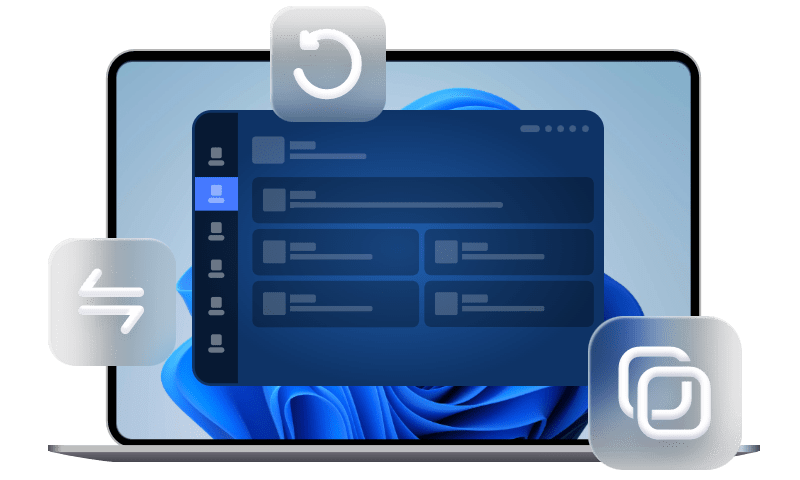How to Restore Full Screen on Windows 10/11: 6 Quick Fixes
Looking for how to restore full screen Windows 10/11? Follow this easy guide to return to full screen on your laptop or desktop for better optimal display experience now.
How do I get my screen back to full size in Windows 10?
Having inadvertently reduced the size of my laptop screen. How do I get back to a full screen with Windows 10? Grateful for your help.
- Microsoft Community
If you suddenly notice your screen shrinking or a program no longer occupying the full screen, you're likely looking for how to restore full screen on Windows 10/11.
Full-screen mode offers a clean, distraction-free interface for apps and games, and it's a great way to maximize your workspace. But what if your screen isn't displaying that way anymore? Whether you're using Windows 10 or Windows 11, this issue can be frustrating, but don't worry - there are several ways to get your screen back to full size.
👉Note: It is recommended to backup your Windows system or important files before doing any major changes on computer.
How to restore full screen on Windows 10/11 in 6 Ways
Now, let’s explore 6 effective solutions for how to restore full screen on laptopor desktop on Windows 10/11 system.
Tip 1. Use keyboard shortcut
One of the quickest ways to restore full screen in Windows 10 is by using the built-in keyboard shortcuts. This method works for most applications and web browsers. Here’s how to restore full screen on Windows 10/11 using keyboard:
- In most applications like web browsers (Google Chrome, Firefox, etc.), pressing F11, which is the shortcut key for full screen in Windows 10/11, will instantly maximize the window to full screen.
- For how to full screen Windows 10 without F11, try the Alt + Enter keyboard combination, which is another commonly used shortcut for full-screen mode.
Tip 2. Maximize your windows
If you're not in full-screen mode but just have a resizable window, you can easily maximize it to take up the full screen. Here’s how to do that:
- In the upper-right corner of the window, locate the square icon (next to the close X button). Simply click the maximize button, and the window will expand to fill the screen.
Alternatively, you can drag the window's edge to the top of your screen until the cursor changes, which will maximize the window.
Tip 3. Adjust display settings
Sometimes, the issue may not be with the app, but rather your screen resolution or display settings. If the display is incorrectly set, you might find that the full-screen feature doesn’t work properly. Here’s how you can adjust these settings:
Step 1. Right-click anywhere on your desktop and select Display settings from the context menu.
Step 2. Under the Display section, check the Display Resolution. Ensure that the resolution is set to the recommended setting for your monitor.
Step 3. Scroll down to the Scale and Layout section. Set the scaling to 100% (or whatever is recommended for your screen) to ensure windows are displayed correctly.
Tip 4. Update or roll back graphics driver
Outdated or corrupted graphics drivers can sometimes cause screen issues, including problems with full-screen display. To return to full screen on Windows 10, you may need to update or roll back your graphics drivers. Here’s how to get back to full screen on Windows 10:
Step 1. Press the Windows Key + X and select Device Manager. Scroll down and expand the Display Adapters section.
Step 2. Right-click your graphics driver (such as Intel, NVIDIA, or AMD) and select Update Driver.
Step 3. You can choose Search Automatically for Drivers or Browse My Computer for Drivers, depending on how you want to update the driver.
You could also right-click the graphics driver again in Device Manager and select Properties. Go to the Driver tab and click Roll back driver (if the option is available).
Tip 5. Force an application into full screen
Sometimes, an application might not automatically enter full-screen mode, even if you're pressing the right buttons. In this case, you may need to force it into full screen. Here’s how to make full screen on Windows 11/10:
As mentioned above, many games or media players support the Alt + Enter shortcut to toggle full screen on or off. Simply press these keys together to force the app into full-screen mode. If the app has an internal setting for full-screen mode (for instance, many video players or games have a full-screen toggle in the settings), be sure to enable it manually.
Tip 6. Reinstall or Update your system
If none of the above methods work, there may be a deeper issue with your Windows 10 or 11 system. Corrupted system files or outdated software can prevent full-screen functionality. Here’s how you can fix it:
Step 1. Go to Settings > Update & Security > Windows Update, and click Check for Updates. Install any available updates.
Step 2. If updates don't resolve the issue, you might consider resetting your Windows installation. Go to Settings > Update & Security > Recovery, and select Get Started under Reset this PC.
Step 3. If a reset doesn’t work, you can perform a full reinstall of Windows 10/11 by downloading the Windows installation media from the official Microsoft website.
Always Backup Your Windows 10/11 to Keep Data Safe
It’s always a good idea to back up your data regularly, especially before performing major system changes like reinstalling Windows. AOMEI Backupper Standard is an excellent tool for backing up and protecting your Windows computer.

- Full backup options - Allow you to create system backup, file backup, disk backup, and partition backup of your Windows 10/11.
- Schedule backups - Set up automatic backups to run at specific times, ensuring your data is always up to date
- Recovery disk creation - Except for data backup, it enables you to create Windows 10/11 recovery disk with DVD/CD or USB for disaster recovery.
For how to backup your Windows 10 system, please follow the tutorial below:
Step 1. Download and run AOMEI Backupper Standard, select the Backup > System Backup option from the main screen.
Step 2. It will select system partition and boot-related partitions automatically. And you only need to select a destination. (external hard drives, cloud storage, or network locations are supported)
Step 3. Click Start Backup to create a Windows system image.
In the end
Restoring full screen on Windows 10 or 11 can be accomplished in a variety of ways, depending on the root cause of the issue. From using simple keyboard shortcuts to adjusting your display settings or even reinstalling Windows, there are several techniques you can try.
But don't forget using a backup solution like AOMEI Backupper Standard to ensure that your data remains safe throughout the process. With this freeware, you could easily perform system restore to restore your computer to an earlier date when your computer crashes.

